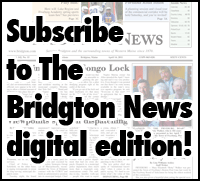Casco says ‘no’ to delineators
By Dawn De Busk
Staff Writer
CASCO — Casco citizens like the idea of having more pedestrian-friendly areas, where neighbors could go for a stroll and families could take a bike ride — all the while feeling safe.
Apparently, putting white posts on the white line of Route 121 was not the ideal situation being sought.
On Tuesday, several residents stepped up and said no to re-installing the delineators that were put up last fall on the edge of Meadow Road, from the Casco Town Office to Casco Village.
Casco Town Manager Anthony “Tony” Ward introduced the topic.
Installing delineators was a temporary solution that came out of the comprehensive plan process, he said. At those initial comp plan gatherings, many people expressed a concern about excessive speeding on Meadow Road as well as on other roads in town. Simultaneously, residents said they wanted places in town, where they could walk or bike next to the road while feeling safe from the passing traffic.
“One of the trials was using delineators. We did a partial installation. The feedback I got was mixed. People who were walkers enjoyed it. Everyone else despised it,” Ward said.
Putting delineators on the white line is one method used to encourage drivers to slow down because the road appears to be narrow.
“There is no doubt it slowed people down. There is no ifs ands or buts about it, it did slow traffic down, which was our primary purpose,” Selectman Grant Plummer said. “I don’t know what to say to people who complain about people driving the speed limit or less.”
Resident Lynne Potter shared her thoughts.
“I think the delineators in the village might be a good idea because you have people crossing the street to go to church, or come over to the post office or the community center or the library,” she said.
“But, if you put the delineators in an area that is classified as 50 mph and then you have somebody on Route 11 that is in 45 or 50 mph and they want to walk there and you put up delineators, you are opening up a can of worms,” she said.
“The delineators where you put them in relation to the edge of the road is minimal. It is not wide enough for a sidewalk, it is not wide enough for a bicycle, it is not wide enough for walking. So, what are you accomplishing exactly? If people want to walk, the delineators are not going to give them the room to do that,” Potter said.
She said the delineators add to the danger of driving there because not only do animals such as deer and fox travel across Route 121 to get to the water, but also logging truck, RVs and trucks hauling boats use that stretch of road.
Tom Mulkern stated his opposition and offered alternative solutions.
“I am opposed to putting the white posts back in the road,” he said.
An effective way to address speeding is to work with the Maine Department of Transportation (DOT) to lower the speed limit “that was set at 50 mph when no houses there. It should really be down to 40 or 35 mph,” Mulkern said.
Harrison and Windham have been successful with flashing speed limit signs put permanently in troublesome spots, he said.
Cumberland County Sheriff’s Office (CCSO) has funds dedicated to speed enforcement, and the town can request monetary help, he said.
The white posts on the road “put a squeeze on the traffic in a way that is extremely unsafe,” Mulkern said.
Ilene Tidd
“I want to thank the board for trying to do something to slow down the traffic,” she began. “I am opposed to the white posts. I do see them as a danger — the reflective glare, narrowing the space. I like the idea of the flashing speed limit sign.”
Rob McAllister warned against turning to the DOT for the speed-reduction solution. In some towns, the DOT does its survey and determines the conditions allow for a higher speed limit, and the town ends up with a 5 mph increase instead of a decrease, he said.
“Issue number one is speed. It’s in our whole mentality and how we conduct our days,” Selectman Scott Avery said. “We still have a small town, where people like to get out for a walk.”
“We should do extra research. I am not against the fact we did it. Maybe, there is something out there we can do,” he said.
Ward said there are plenty of options such as pop outs and sidewalks. The latter is more challenging and more expensive.


